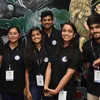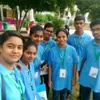Team Kalam’s Dream develops a system to secure data transfer at Smart India Hackathon, wins Rs 1 lakh
Engineering students from Tamil Nadu develop a solution to protect cyber threats at the SIH that helps protect private networks from data breach.
In an age where cyber threats and data breaches are threatening businesses worldwide, securing data is crucial. As per a Juniper research, losses due to cyber-crimes in 2019 was $2 trillion. Hacking on the other hand costs a meagre $1. In an era where digitisation is the way forward, there is no escaping the need for data security. At the Smart India Hackathon, Team Kalam’s Dream innovated to protect data breach.
Students from RMK Engineering College in Tamil Nadu won a cash prize of Rs 75,000 in the complicated category, at the recently-held Smart India Hackathon 2019-hardware edition at Reva University for their system which secures data.
The team proposed a Data Transfer Portal model to secure a private network through the Internet which helps data transfer between a local area network of businesses and the Internet. This solves the problem of insecure data transfer using technologies such as digital signature, secure socket layer, key mechanisms, etc.
1564138444749.png?fm=png&auto=format)
Team Kalam at the hardware edition of Smart India Hackathon 2019
A study by the Ponemon Institute’s 2018 for IBM reveals that the cost of the average data breach to companies worldwide is $3.86 million. As more and more companies take the digital route to improve efficiency in business operations, the more they are vulnerable to cyber attacks.
A secure dream
Team Kalam’s Dream was led by Allamadhev G (20). The other team members included Dwaraka Prasath M (20), Naresh Babu G (20), Karthikeyan P (20), Vinitha K S (20) and Shivani P (20). The students are passionate about networking, and came up with a solution to cyber threats.
“Everyone uses a mobile phone these days, yet they have very little knowledge about how secure their phone is. People are very quick to log into free public wifi, not realising a public network is most vulnerable to hackers. All they care about is that it’s free,” says team member Dwaraka Prasath, 20.
How it works?
When it comes to cyber security, one of the challenges companies face is a breach of their private network. Team Kalam’s Dream’s innovation reduces this risk.
They used a traditional Virtual Private Network (VPN), Ngrok to build their application and customised it to suit the requirements of the company, in this case, Bharat Earth Movers Limited (BEML).
There are certain features that make their portal different from existing VPN’s like OpenVPN, SoftEther VPN and ProtonVPN.
One is that it can be customised based on the company's requirement. The second feature is role authorisation which is not available in other VPN’s. Their system also has a website to monitor the usage.
“Our innovation is a priority-based management system. Each employee will be given restricted access on the network based on their position,” says Dwaraka.
Since coding is organisation-specific, it is difficult for any third party to hack into the system. For the competition, a Microsoft firewall was used as the device was only a prototype, and not ready for the market. The team is currently unable to price it for the same reason. However, based on BEML’s feedback, they plan on upgrading the system using more advanced technology, following which the price will be decided.
The Central government initiated the Smart India Hackathon (SIH) in 2017 to instill and foster innovation among students. This was the third SIH that saw innovation and inventions that aimed to solve problems in diverse fields.
(Edited by Suruchi Kapur-Gomes)


1564138444749.png?mode=crop&crop=faces&ar=2%3A1&format=auto&w=1920&q=75)



1564064110088.png?fm=png&auto=format&h=100&w=100&crop=entropy&fit=crop)




